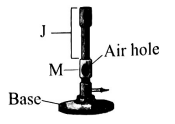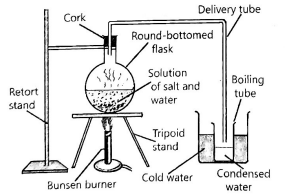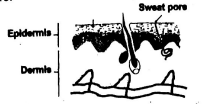QUESTIONS
- The diagram below shows a bunsen burner.
Identify and name the parts labelled J and M. (2mks) - A learner in grade 7 observed a patient who had been injured being given a first aid by pouring cold water on the injury. Which laboratory accident was the student likely to have? (1mk)
- Draw a hazard symbol that is likely to be found on toxic chemical container. (3mks)
- Identify two heterogenous liquid mixtures that you are likely to find at homes. (2mks)
- The diagram below shows a set-up that was used during an Integrated Science lesson.
)
- Identify the method of separating mixture shown. (1mk)
- Name two mixtures that can be separated using the set-up shown. (2mks)
- Explain the following terms as used in separation of different mixtures. (4mks)
- Sublimation
- Chromatography
- Identify and give two examples of acids and bases. (4mks)
- Acids -
- Bases -
- Differentiate between acids and bases using a pH scale chart. (3mks)
- Name three safety equipment that one should put on while working in laboratory when dealing with harmful chemicals. (3mks)
- Complete the table below showing units for the following derived quantities. (3mks)
Derived quantities SI units Area Volume Density - State three reasons why it is important to read packaging labels of products. (3mks)
- Name the equipment that will be used to perform the following tasks in the laboratory. (3mks)
- Holding solid substances when heating. ______________________________
- Transferring small amounts of fixed volume of liquid. _____________________________
- For measuring temperature. _____________________________
- State one application of acid in real life. (2mks)
- What is the name given to the process whereby a mature ovum is released from the ovary down to the fallopian tube? (1mk)
- Explain what is fertilization in human being. (2mks)
- Draw part of a skin and label the following parts correctly: Dermis, epidermis and sweat pore. (6mks)
- Which lifestyles should a person adopt to promote a healthy skin. (3mks)
- List two kidney disorders. (2mks)
MARKING SCHEME
- J - Chimney
- M - Collar
- Burn and scald
-
-
- Milk and kerosene
- Water and Cooking oil
-
- Simple distillation
- Water and salt
Water and sugar
-
- Sublimation - The process where solid changes to gases directly and heating
- Chromatography - The method of separating mixtures of colours
-
- Acids - Sour milk, lemon juice, orange juice
- Bases - Soap solution, baking powder solution, ash solution
-
- Gloves, goggles, apron
Derived quality SI units Area m2 Volume m3 Density kg/m3 -
- Knowing expiry date.
- Knowing measure to observe
- Knowing the quantity of the product
- Knowing how to store
-
- Tongs
- Pipette
- Thermometer
- Making fertilizer, juice, car batteries and making colours
- Ovulation
- Fusion of male and female gametes
-
-
- Drinking clean and safe water.
- Taking healthy food.
- Enough sleep
-
- Kidney failure
- Kidney stones
Join our whatsapp group for latest updates
Tap Here to Download for 30/-
Get on WhatsApp for 30/-
Download Integrated Science Questions and Answers - Grade 7 End Term 2 Exams 2023 Set 1.
Tap Here to Download for 30/-
Get on WhatsApp for 30/-
Why download?
- ✔ To read offline at any time.
- ✔ To Print at your convenience
- ✔ Share Easily with Friends / Students


 )
)
